Papers by Byoung-Cheorl Kang
Plant Breeding and Biotechnology, 2015
Journal of Plant Biology, 1997
Although this research program is in the state of beginning, it seems like that the progress will... more Although this research program is in the state of beginning, it seems like that the progress will be made more rapidly than expected. The reason is because new techniques and facilities derived from human genome research and other advanced genome program will overcome the current limitations and difficulties. Genome research cannot be accomplished by one or two research groups. That is why the program should be well organized and planned by scientists in various fields with common interest. Considering the tremendous amounts of time, money, and efforts required for performing genome research, the genome research programs should aim at concrete goals, such as getting new solutions that cannot be obtained by conventional approach, rather than remain as research for research is sake.

Journal of Plant Biology, 2008
We have regenerated altotetraploid plants that are interspecific somatic hybrids between Citrus s... more We have regenerated altotetraploid plants that are interspecific somatic hybrids between Citrus sinensis Osbeck cv. Yoshida navel orange and Citrus unshiu Marc cv. Okitsu satsuma mandarin. Protoplasts isolated from ‘Yoshida’ leaves were chemically fused with call us-derived protoplasts from ‘Okitsu’. After 6 months of culture, 102 plants were obtained. These hybrids were identified by differential leaf morphology, DNA fluorescence intensity, and DNA analysis. Ploidy analysis via the flow cytometry revealed that 15 of the 102 plants were tetraploids, with the rest being diploids that morphologically resembled their mesophyll parent. SRAP analysis confirmed that 9 of the tetraploid plants were allotetraploid somatic hybrids. These will be utilized as a possible pollen parents for improving seedy citrus cultivars, e.g., ponkan, mandarin, lemon and kumquat, in order to produce triploid seedless hybrids.
Genetics, 2009
Comparative genomics provides a powerful tool for the identification of genes that encode traits ... more Comparative genomics provides a powerful tool for the identification of genes that encode traits shared between crop plants and model organisms. Pathogen resistance conferred by plant R genes of the NB-LRR class is one such trait with great agricultural importance that occupies a critical position in understanding fundamental processes of pathogen detection and coevolution. The proposed rapid rearrangement of R genes in genome evolution would make comparative approaches tenuous. Here, we test the hypothesis that orthology is predictive of R gene genomic location in the Solanaceae using the pepper R gene Bs2. Homologs of Bs2 were compared in terms of sequence and gene and protein architecture. Comparative mapping demonstrated Bs2 shared macrosynteny with R genes that best fit criteria to be its orthologs.
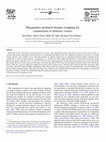
Journal of Virological Methods, 2006
Clones that encode viral genomes constructed from two viruses with contrasting biological propert... more Clones that encode viral genomes constructed from two viruses with contrasting biological properties have been widely used in studies of viral-host interactions, particularly when the objective is to determine the identity of the viral component recognized by the host in a resistant response, known as the avirulence factor. This paper presents an efficient method based on megaprimer-mediated domain swapping for the construction of clones encoding chimeric viral genomes as a versatile and widely applicable alternative to conventional restriction enzyme digestion and ligation methods. Potato virus X (PVX)-derived vectors expressing genes encoding fluorescent proteins were used to demonstrate this concept. The cyan fluorescent protein (CFP) gene was cloned into a binary PVX vector and subsequently replaced with the yellow fluorescent protein (YFP) gene using the megaprimer amplification reaction. DNA fragments up to 1480 bp could be replaced efficiently and quickly. Most viral clones showed the expected change in phenotype without altered infectivity. Sequence analysis revealed mutations were not introduced into the four domain-swapped plasmids. This approach will provide a valuable tool for determining which domains of a viral genome are essential for infectivity, avirulence, or otherwise determine biologically significant properties of plant viruses. (I. Yeam), mmj9@cornell.edu (M.M. Jahn), bk54@snu.ac.kr (B.-C. Kang).
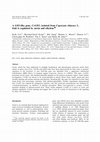
Plant Molecular Biology, 2005
Auxin, which has been implicated in multiple biochemical and physiological processes, elicits thr... more Auxin, which has been implicated in multiple biochemical and physiological processes, elicits three classes of genes (Aux/IAAs, SAURs and GH3s) that have been characterized by their early or primary responses to the hormone. A new GH3-like gene was identified from a suppressive subtraction hybridization (SSH) library of pungent pepper (Capsicum chinense L.) cDNAs. This gene, CcGH3, possessed several auxin- and ethylene-inducible elements in the putative promoter region. Upon further investigation, CcGH3 was shown to be auxin-inducible in shoots, flower buds, sepals, petals and most notably ripening and mature pericarp and placenta. Paradoxically, this gene was expressed in fruit when auxin levels were decreasing, consistent with ethylene-inducibility. Further experiments demonstrated that CcGH3 was induced by endogenous ethylene, and that transcript accumulation was inhibited by 1-methylcyclopropene, an inhibitor of ethylene perception. When over-expressed in tomato, CcGH3 hastened ripening of ethylene-treated fruit. These results implicate CcGH3 as a factor in auxin and ethylene regulation of fruit ripening and suggest that it may be a point of intersection in the signaling by these two hormones.

Annual Review of Phytopathology, 2005
■ Abstract Genetic resistance to plant viruses has been used for at least 80 years to control agr... more ■ Abstract Genetic resistance to plant viruses has been used for at least 80 years to control agricultural losses to viral diseases. To date, hundreds of naturally occurring genes for resistance to plant viruses have been reported from studies of both monocot and dicot crops, their wild relatives, and the plant model, Arabidopsis. The isolation and characterization of a few of these genes in the past decade have resulted in detailed knowledge of some of the molecules that are critical in determining the outcome of plant viral infection. In this chapter, we have catalogued genes for resistance to plant viruses and have summarized current knowledge regarding their identity and inheritance. Insofar as information is available, the genetic context, genomic organization, mechanisms of resistance and agricultural deployment of plant virus resistance genes are also discussed.
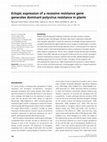
Plant Biotechnology Journal, 2007
Despite long-standing plant breeding investments and early successes in genetic engineering, plan... more Despite long-standing plant breeding investments and early successes in genetic engineering, plant viral pathogens still cause major losses in agriculture worldwide. Early transgenic approaches involved the expression of pathogen-derived sequences that provided limited protection against relatively narrow ranges of viral pathotypes. In contrast, this study demonstrates that the ectopic expression of pvr1, a recessive gene from Capsicum chinense, results in dominant broad-spectrum potyvirus resistance in transgenic tomato plants (Solanum lycopersicum). The pvr1 locus in pepper encodes the eukaryotic translation initiation factor eIF4E. Naturally occurring point mutations at this locus result in monogenic recessive broad-spectrum potyvirus resistance that has been globally deployed via plant breeding programmes for more than 50 years. Transgenic tomato progenies that over-expressed the Capsicum pvr1 allele showed dominant resistance to several tobacco etch virus strains and other potyviruses, including pepper mottle virus, a range of protection similar to that observed in pepper homozygous for the pvr1 allele.
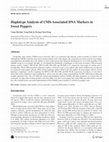
Journal of Crop Science and Biotechnology, 2009
Cytoplasmic male sterility (CMS)/restorer-of-fertility (Rf) is an economical and efficient system... more Cytoplasmic male sterility (CMS)/restorer-of-fertility (Rf) is an economical and efficient system to produce F1 hybrid seeds. Although the CMS/Rf system has been used to produce hybrid seeds of hot peppers, this system has never been used for sweet pepper seed production, presumably due to the inability to select stable restorer lines during the breeding process. To test the feasibility of the CMS/Rf system in sweet pepper breeding, we investigated the distribution of haplotypes of previously developed, CMS-associated markers (orf456, ψ atp6-2, CRF-SCAR, OPP13-CAPS, PR-CAPS, and PR-SNP) in 27 commercial sweet pepper F1 hybrids and 12 breeding lines. When CMS-associated cytoplasmic markers orf456 and ψ atp6-2 were applied, male sterile cytoplasm was not detected in commercial sweet pepper cultivars. When nuclear haplotype markers linked to Rf were applied, all sweet pepper cultivars showed haplotype 3, haplotype 1, and the rf genotype for OPP13-CAPS, PR-CAPS, and CRF-SCAR, respectively. In contrast, we were able to detect male sterile cytoplasm in some breeding lines, and we were also able to detect polymorphisms for PR-CAPS between stable and unstable maintainer lines. The 17T7-SNP also showed polymorphisms between unstable and stable maintainer (or restorer) lines. In conclusion, we expect that it will be possible to develop stable A, B, and C sweet pepper lines using CMS-associated markers and that this will eventually lead to successful implementation of the CMS/Rf system to produce F1 hybrid sweet pepper seeds.
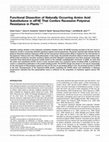
Plant Cell, 2007
Naturally existing variation in the eukaryotic translation initiation factor 4E (eIF4E) homolog e... more Naturally existing variation in the eukaryotic translation initiation factor 4E (eIF4E) homolog encoded at the pvr1 locus in Capsicum results in recessively inherited resistance against several potyviruses. Previously reported data indicate that the physical interaction between Capsicum-eIF4E and the viral genome-linked protein (VPg) is required for the viral infection in the Capsicum-Tobacco etch virus (TEV) pathosystem. In this study, the potential structural role(s) of natural variation in the eIF4E protein encoded by recessive resistance alleles and their biological consequences have been assessed. Using highresolution three-dimensional structural models based on the available crystallographic structures of eIF4E, we show that the amino acid substitution G107R, found in many recessive plant virus resistance genes encoding eIF4E, is predicted to result in a substantial modification in the protein binding pocket. The G107R change was shown to not only be responsible for the interruption of VPg binding in planta but also for the loss of cap binding ability in vitro, the principal function of eIF4E in the host. Overexpression of the Capsicum-eIF4E protein containing the G107R amino acid substitution in Solanum lycopersicum indicated that this polymorphism alone is sufficient for the acquisition of resistance against several TEV strains.

Theoretical and Applied Genetics, 2006
Pungency or “heat” found in Capsicum fruit results from the biosynthesis and accumulation of alka... more Pungency or “heat” found in Capsicum fruit results from the biosynthesis and accumulation of alkaloid compounds known as capsaicinoids in the dissepiment, placental tissue adjacent to the seeds. Pepper cultivars differ with respect to their level of pungency because of quantitative and qualitative variation in capsaicinoid content. We analyzed the segregation of three capsaicinoids: capsaicin, dihydrocapsaicin and nordihydrocapsaicin in an inter-specific cross between a mildly pungent Capsicum annuum ‘NuMex RNaky’ and the wild, highly pungent C. frutescens accession BG2814-6. F3 families were analyzed in three trials in California and in Israel and a dense molecular map was constructed comprised mostly of loci defined by simple sequence repeat (SSR) markers. Six QTL controlling capsaicinoid content were detected on three chromosomes. One gene from the capsaicinoid biosynthetic pathway, BCAT, and one random fruit EST, 3A2, co-localized with QTL detected in this study on chromosomes 3 and 4. Because one confounding factor in quantitative determination of capsaicinoid is fruit size, fruit weight measurements were taken in two trials. Two QTL controlling fruit weight were detected, however, they did not co-localize with QTL detected for capsaicinoid content. The major contribution to the phenotypic variation of capsaicinoid content (24–42% of the total variation) was attributed to a digenic interaction between a main-effect QTL, cap7.1, and a marker located on chromosome 2 that did not have a main effect on the trait. A second QTL, cap7.2 is likely to correspond to the QTL, cap, identified in a previous study as having pronounced influence on capsaicinoid content.
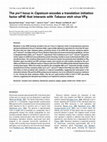
Plant Journal, 2005
Mutations in the eIF4E homolog encoded at the pvr1 locus in Capsicum result in broad-spectrum pot... more Mutations in the eIF4E homolog encoded at the pvr1 locus in Capsicum result in broad-spectrum potyvirus resistance attributed to the pvr1 resistance allele, a gene widely deployed in agriculture for more than 50 years. We show that two other resistance genes, previously known to be eIF4E with narrower resistance spectra, pvr21 and pvr22, are alleles at the pvr1 locus. Based on these data and current nomenclature guidelines, we have re-designated these alleles, pvr11 and pvr12, respectively. Point mutations in pvr1, pvr11, and pvr12 grouped to similar regions of eIF4E and were predicted by protein homology models to cause conformational shifts in the encoded proteins. The avirulence determinant in this potyvirus system has previously been identified as VPg, therefore yeast two-hybrid and GST pull-down assays were carried out with proteins encoded by the pvr1 alleles and VPg from two different strains of Tobacco etch virus (TEV) that differentially infected Capsicum lines carrying these genes. While the protein encoded by the susceptible allele pvr1+ interacted strongly, proteins translated from all three resistance alleles (pvr1, pvr11, and pvr12) failed to bind VPg from either strain of TEV. This failure to bind correlated with resistance or reduced susceptibility, suggesting that interruption of the interaction between VPg and this eIF4E paralog may be necessary, but is not sufficient for potyvirus resistance in vivo. Among the three resistance alleles, only the pvr1 gene product failed to bind m7-GTP cap-analog columns, suggesting that disrupted cap binding is not required for potyvirus resistance.

Molecular Breeding, 2010
The Restorer-of-fertility (Rf) gene is used for efficient hybrid seed production in chili pepper.... more The Restorer-of-fertility (Rf) gene is used for efficient hybrid seed production in chili pepper. Although molecular markers linked to Rf in pepper are available, their applications have been limited by lack of agreement between marker genotype and phenotype. To overcome this limitation, we developed new molecular markers using an Rf-segregating population for which most of previously developed markers are not suitable, because of lack of polymorphism. The petunia Rf gene was used as a candidate for marker development. First of all, a pepper bacterial artificial chromosome (BAC) library was screened using a pepper homolog of the petunia Rf gene. The 52 selected BAC clones were classified into three contig groups and each contig group was mapped to chromosome 6. Three markers were developed using the three groups; their genetic distances from the Rf locus were 1.4, 3.2 and 14 cM, respectively. In the second place, an Rf-linked marker was developed from the sequence of a tomoto BAC clone containing three genes which are homologous to petunia Rf gene. Genetic distance between this marker and Rf gene was 1.4 cM. When newly-, and previously-developed molecular markers linked to Rf were applied to 55 pepper breeding lines, one marker named CRF-SCAR was found to be the most broadly applicable, based on correct determination of phenotypes. In the present study, we demonstrate that previously cloned Rf genes can be used as candidate genes for development of new markers for the reliable detection of restorer lines. We expect that the newly-developed markers and information obtained from application of markers will be useful for reliable detection of restorer lines.
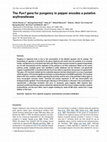
Plant Journal, 2005
Pungency in Capsicum fruits is due to the accumulation of the alkaloid capsaicin and its analogs.... more Pungency in Capsicum fruits is due to the accumulation of the alkaloid capsaicin and its analogs. The biosynthesis of capsaicin is restricted to the genus Capsicum and results from the acylation of an aromatic moiety, vanillylamine, by a branched-chain fatty acid. Many of the enzymes involved in capsaicin biosynthesis are not well characterized and the regulation of the pathway is not fully understood. Based on the current pathway model, candidate genes were identified in public databases and the literature, and genetically mapped. A published EST co-localized with the Pun1 locus which is required for the presence of capsaicinoids. This gene, AT3, has been isolated and its nucleotide sequence has been determined in an array of genotypes within the genus. AT3 showed significant similarity to acyltransferases in the BAHD superfamily. The recessive allele at this locus contains a deletion spanning the promoter and first exon of the predicted coding region in every non-pungent accession tested. Transcript and protein expression of AT3 was tissue-specific and developmentally regulated. Virus-induced gene silencing of AT3 resulted in a decrease in the accumulation of capsaicinoids, a phenotype consistent with pun1. In conclusion, gene mapping, allele sequence data, expression profile and silencing analysis collectively indicate that the Pun1 locus in pepper encodes a putative acyltransferase, and the pun1 allele, used in pepper breeding for nearly 50 000 years, results from a large deletion at this locus.
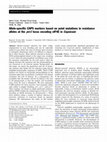
Theoretical and Applied Genetics, 2005
Marker-assisted selection has been widely implemented in crop breeding and can be especially usef... more Marker-assisted selection has been widely implemented in crop breeding and can be especially useful in cases where the traits of interest show recessive or polygenic inheritance and/or are difficult or impossible to select directly. Most indirect selection is based on DNA polymorphism linked to the target trait, resulting in error when the polymorphism recombines away from the mutation responsible for the trait and/or when the linkage between the mutation and the polymorphism is not conserved in all relevant genetic backgrounds. In this paper, we report the generation and use of molecular markers that define loci for selection using cleaved amplified polymorphic sequences (CAPS). These CAPS markers are based on nucleotide polymorphisms in the resistance gene that are perfectly correlated with disease resistance, the trait of interest. As a consequence, the possibility that the marker will not be linked to the trait in all backgrounds or that the marker will recombine away from the trait is eliminated. We have generated CAPS markers for three recessive viral resistance alleles used widely in pepper breeding, pvr1, pvr1 1, and pvr1 2. These markers are based on single nucleotide polymorphisms (SNPs) within the coding region of the pvr1 locus encoding an eIF4E homolog on chromosome 3. These three markers define a system of indirect selection for potyvirus resistance in Capsicum based on genomic sequence. We demonstrate the utility of this marker system using commercially significant germplasm representing two Capsicum species. Application of these markers to Capsicum improvement is discussed.
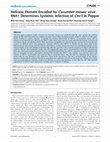
PLOS One, 2012
The Cmr1 gene in peppers confers resistance to Cucumber mosaic virus isolate-P0 (CMV-P0). Cmr1 re... more The Cmr1 gene in peppers confers resistance to Cucumber mosaic virus isolate-P0 (CMV-P0). Cmr1 restricts the systemic spread of CMV strain-Fny (CMV-Fny), whereas this gene cannot block the spread of CMV isolate-P1 (CMV-P1) to the upper leaves, resulting in systemic infection. To identify the virulence determinant of CMV-P1, six reassortant viruses and six chimeric viruses derived from CMV-Fny and CMV-P1 cDNA clones were used. Our results demonstrate that the C-terminus of the helicase domain encoded by CMV-P1 RNA1 determines susceptibility to systemic infection, and that the helicase domain contains six different amino acid substitutions between CMV-Fny and CMV-P1 . To identify the key amino acids of the helicase domain determining systemic infection with CMV-P1, we then constructed amino acid substitution mutants. Of the mutants tested, amino acid residues at positions 865, 896, 957, and 980 in the 1a protein sequence of CMV-P1 affected the systemic infection. Virus localization studies with GFP-tagged CMV clones and in situ localization of virus RNA revealed that these four amino acid residues together form the movement determinant for CMV-P1 movement from the epidermal cell layer to mesophyll cell layers. Quantitative real-time PCR revealed that CMV-P1 and a chimeric virus with four amino acid residues of CMV-P1 accumulated more genomic RNA in inoculated leaves than did CMV-Fny, indicating that those four amino acids are also involved in virus replication. These results demonstrate that the C-terminal region of the helicase domain is responsible for systemic infection by controlling virus replication and cell-to-cell movement. Whereas four amino acids are responsible for acquiring virulence in CMV-Fny, six amino acid (positions at 865, 896, 901, 957, 980 and 993) substitutions in CMV-P1 were required for complete loss of virulence in 'Bukang'.
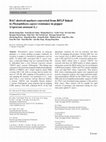
Theoretical and Applied Genetics, 2008
Phytophthora capsici Leonian, an oomycete pathogen, is a serious problem in pepper worldwide. Its... more Phytophthora capsici Leonian, an oomycete pathogen, is a serious problem in pepper worldwide. Its resistance in pepper is controlled by quantitative trait loci (QTL). To detect QTL associated with P. capsici resistance, a molecular linkage map was constructed using 100 F2 individuals from a cross between Capsicum annuum ‘CM334’ and C. annuum ‘Chilsungcho’. This linkage map consisted of 202 restriction fragment length polymorphisms (RFLPs), 6 WRKYs and 1 simple sequence repeat (SSR) covering 1482.3 cM, with an average interval marker distance of 7.09 cM. QTL mapping of Phytophthora root rot and damping-off resistance was performed in F2:3 originated from a cross between resistant Mexican landrace C. annuum ‘CM334’ and susceptible Korean landrace C. annuum ‘Chilsungcho’ using composite interval mapping (CIM) analysis. Four QTL explained 66.3% of the total phenotypic variations for root rot resistance and three 44.9% for damping-off resistance. Of these QTL loci, two were located close to RFLP markers CDI25 on chromosome 5 (P5) and CT211A on P9. A bacterial artificial chromosome (BAC) library from C. annuum ‘CM334’ was screened with these two RFLP probes to obtain sequence information around the RFLP marker loci for development of PCR-based markers. CDI25 and CT211 probes identified seven and eight BAC clones, respectively. Nine positive BAC clones containing probe regions were sequenced and used for cytogenetic analysis. One single-nucleotide amplified polymorphism (SNAP) for the CDI25 locus, and two SSRs and cleaved amplified polymorphic sequence (CAPS) for CT211 were developed using sequences of the positive BAC clones. These markers will be valuable for rapid selection of genotypes and map-based cloning for resistance genes against P. capsici.

Molecular Breeding, 2009
In pepper, the TMV resistance locus L is syntenic to the tomato I2 and the potato R3 loci on chro... more In pepper, the TMV resistance locus L is syntenic to the tomato I2 and the potato R3 loci on chromosome 11. In this report, we identified pepper bacterial artificial chromosome (BAC) clones corresponding to the I2 and R3 loci and developed L-linked markers using the BAC sequence information. A BAC library was screened using the tomato I2C-1 gene as a probe. The resulting clones were sorted further by PCR screening, sequencing, and genetic mapping. A linkage analysis revealed that BAC clone 082F03 could be anchored to the target region near TG36 on chromosome 11. Using the 082F03 sequence, more BAC clones were identified and a BAC contig spanning 224 kb was constructed. Gene prediction analysis showed that there were at least three I2/R3 R gene analogs (RGAs) in the BAC contig. Three DNA markers closely linked (about 1.2 cM) to the L 4 gene were developed by using the BAC contig sequence. The single nucleotide polymorphism marker 087H3T7 developed in this study was subjected to linkage analysis in L 4 - and L 3 -segregating populations together with previously developed markers. The 189D23M marker, which is known to co-segregate with L 3 , was located on the opposite side of 087H3T7, about 0.7 cM away from L 4 . This supports the idea that L 3 and L 4 may be different genes closely linked within the region instead of different alleles at the same locus. Finally, use of flanking markers in molecular breeding program for introgression of L 4 to elite germplasm against most aggressive tobamoviruses pathotype P1,2,3 is discussed.

Molecules and Cells, 2009
To evaluate the involvement of translation initiation factors eIF4E and eIFiso4E in Chilli veinai... more To evaluate the involvement of translation initiation factors eIF4E and eIFiso4E in Chilli veinai mottle virus (ChiVMV) infection in pepper, we conducted a genetic analysis using a segregating population derived from a cross between Capsicum annuum ‘Dempsey’ containing an eIF4E mutation (pvr1 2 ) and C. annuum ‘Perennial’ containing an eIFiso4E mutation (pvr6). C. annuum ‘Dempsey’ was susceptible and C. annuum ‘Perennial’ was resistant to ChiVMV. All F1 plants showed resistance, and F2 individuals segregated in a resistant-susceptible ratio of 166:21, indicating that many resistance loci were involved. Seventy-five F2 and 329 F3 plants of 17 families were genotyped with pvr1 2 and pvr6 allele-specific markers, and the genotype data were compared with observed resistance to viral infection. All plants containing homozygous genotypes of both pvr1 2 and pvr6 were resistant to ChiVMV, demonstrating that simultaneous mutations in eIF4E and eIFiso4E confer resistance to ChiVMV in pepper. Genotype analysis of F2 plants revealed that all plants containing homozygous genotypes of both pvr1 2 and pvr6 showed resistance to ChiVMV. In protein-protein interaction experiments, ChiVMV viral genome-linked protein (VPg) interacted with both eIF4E and eIFiso4E. Silencing of eIF4E and eIFiso4E in the VIGS experiment showed reduction in ChiVMV accumulation. These results demonstrated that ChiVMV can use both eIF4E and eIFiso4E for replication, making simultaneous mutations in eIF4E and eIFiso4E necessary to prevent ChiVMV infection in pepper.

Uploads
Papers by Byoung-Cheorl Kang